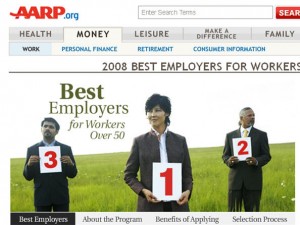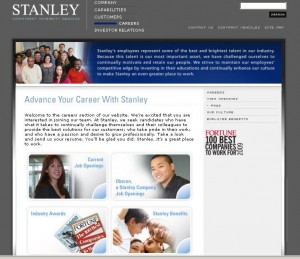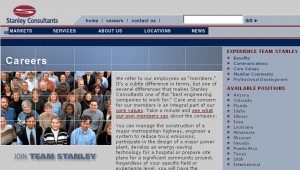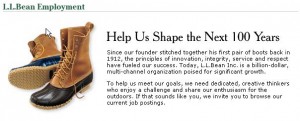Going Gray looked at some of the benefits and challenges associated with recruiting older workers. Recap: 50+ workers represent a cost-effective resource pool, but Careers messaging often ignores them. And as we saw with the comparison of Hewlett-Packard and Securian . . . youth bias can be quite subtle.
To dive a little deeper, let’s consider another pair of examples. Stanley Associates is one of the companies included on Fortune’s 2008 list of 100 Best Companies to Work For. And Stanley Consulting is on the AARP’s 2008 list of Best Employers for Workers Over 50.
Here’s the Careers landing page for Stanley Associates:
Which page makes you feel more welcome? The one with a gray-haired woman in the second row—or the one that spotlights an age range from 3 to 30? (As for that group picture in the upper left of Stanley Associates . . . I’ve zoomed it as far as it will go, and if there’s anyone there over 39, I envy their youthful appearance!)
The Stanley Consulting page reflects the company’s interest in actively recruiting from the 50+ pool. Over-fifties comprise 34% of their workforce, and the average tenure of Stanley’s 50+ employees is just 5.74 years—a very interesting figure, since it means that many of these employees have not aged into the over-fifty category, but were hired in maturity. Among the policies that attract over-fifties to Stanley Consulting: flextime, telecommuting, and phased retirement.
In addition (according to the AARP profile), Stanley Consulting has an employee who is directly responsible for maintaining relationships with its current group of 144 retirees, and the company acknowledges retirees with regular communications, invitations to company events, and opportunities for temporary work assignments, consulting and contract work. As employees age, they have choices about their role with the company.
Which brings us to an often-overlooked point. Even for companies where recruitment priorities skew away from older employees—there is still much value to creating an age-inclusive message on the Careers site. It lets the visitor know that experience and maturity have value to the company. And that message will be meaningful to younger job-seekers (who might, after all, hope for a long career in the company!) as well as older ones.
Finally, it’s worth noticing that a majority of the companies on the AARP list are in the health care field, with insurance and financial services, education, and consulting also well represented. Retail appears to be almost absent—but L.L. Bean makes the list at #20, and their creative approach to age-inclusive messaging is worth a look:
Lucy is Editor at Corporate Eye



